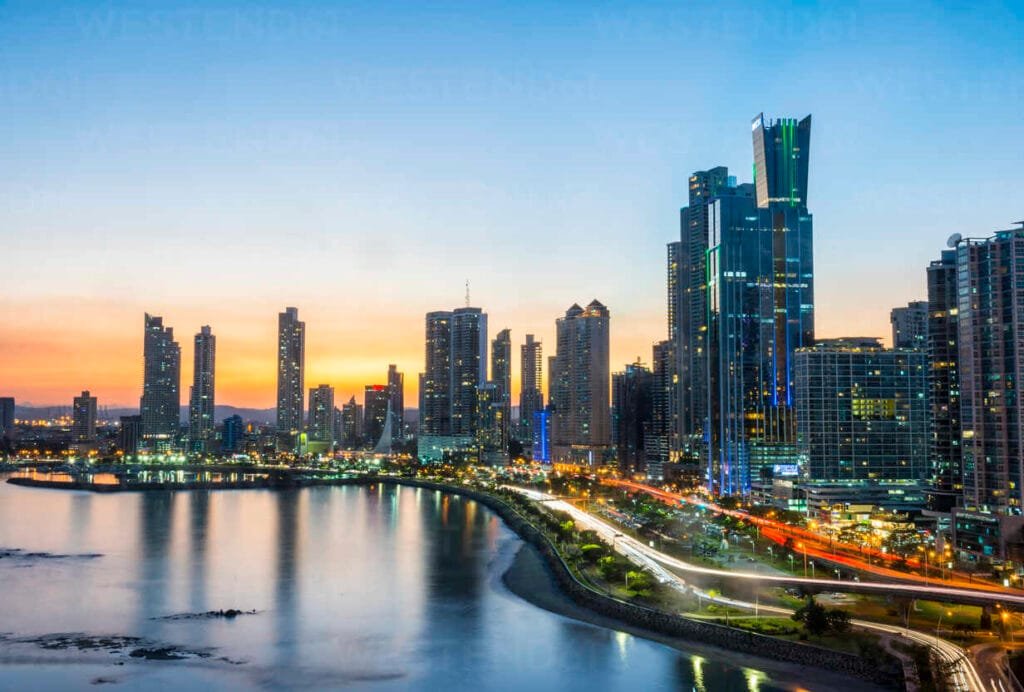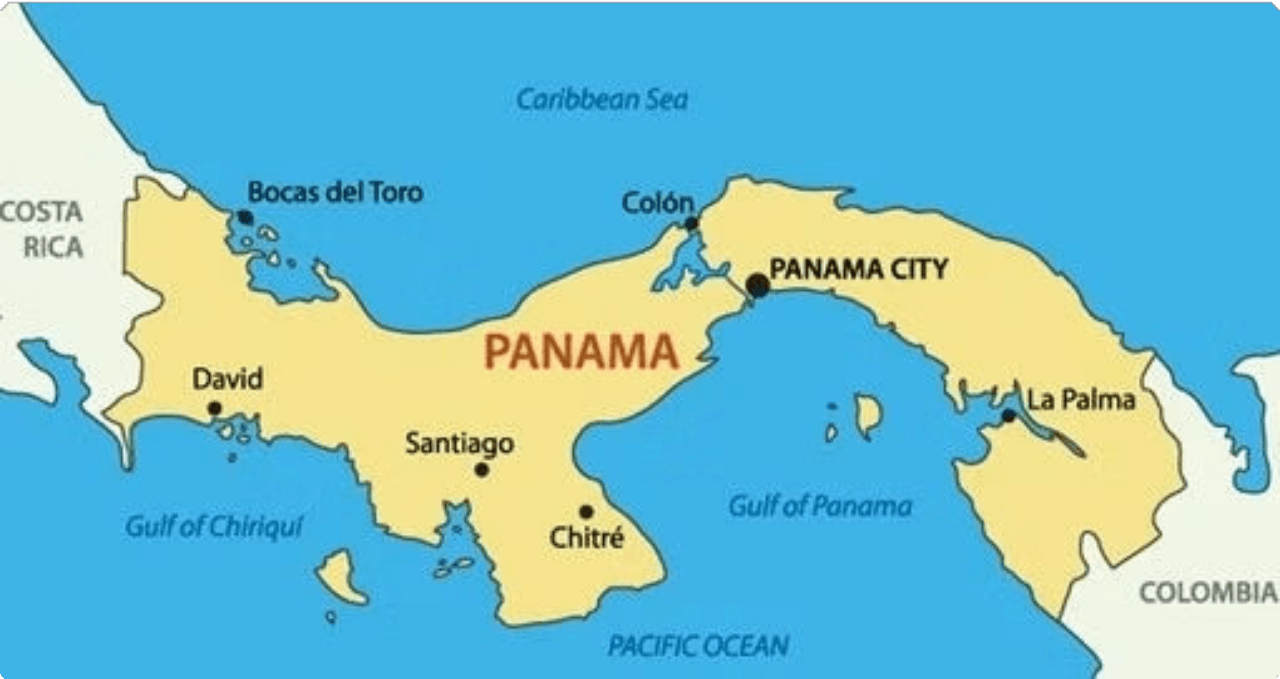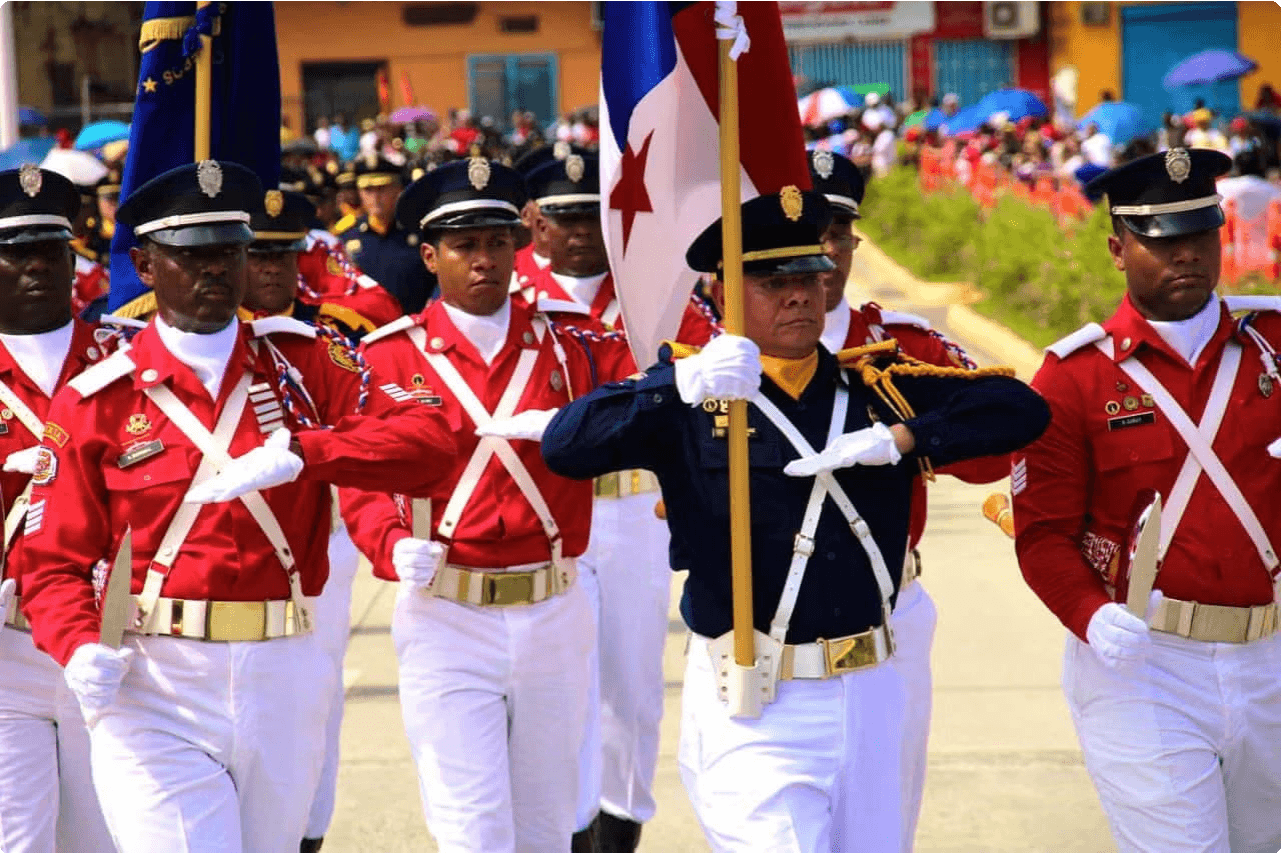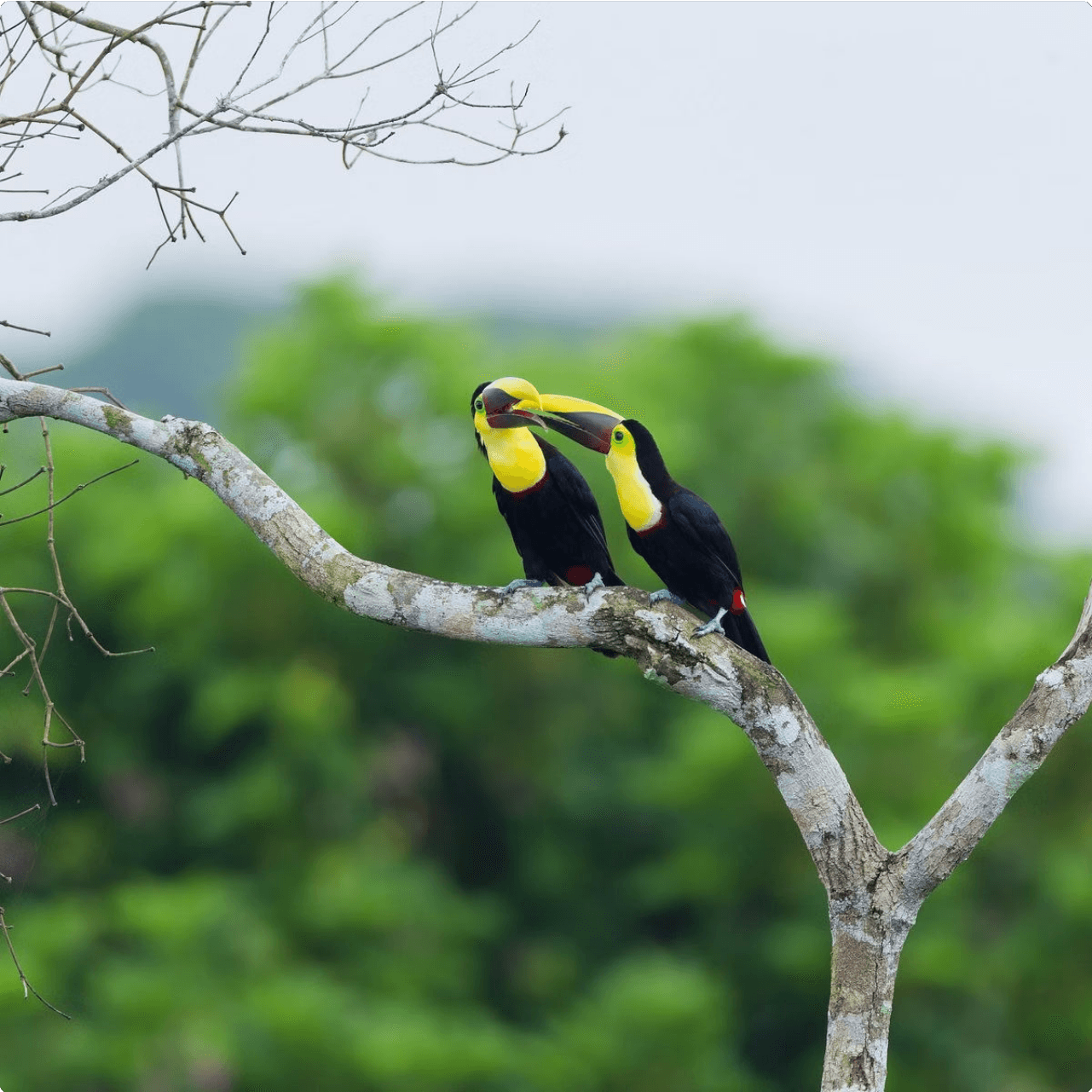Panama
Discover Panama
Panama, a Central American country known for its rich history, diverse culture, and stunning natural landscapes, is a captivating destination that offers a unique blend of modernity and tradition. With its vibrant cities, lush rainforests, and beautiful coastlines, Panama has something to offer for every type of traveler.

Explore the mesmerizing culture, savor the delightful cuisine, and immerse yourself in the rhythmic beats of traditional dances. From the iconic Panama Canal to the colorful festivals, this country is a treasure trove of experiences waiting to be discovered.
Flag of Panama
Design and Symbolism
The flag of Panama features two blue divided by a red stripe. The blue represents the Conservative Party, the red symbolizes the Liberal Party, and the white stands for peace between them.

History and Evolution
The current flag was officially adopted in 1925, based on the original design created in 1903 when Panama gained independence from Colombia.
National Pride
The flag represents Panama’s struggle for independence and its political history, instilling a sense of pride and unity among its people.
Geography and Map
Panama, located in Central America, connects North and South America. It is bordered by Costa Rica to the west and Colombia to the southeast. The country’s unique geography includes the famous Panama Canal, which connects the Atlantic and Pacific oceans, and the diverse terrain of rainforests, mountains, and beaches.

The map of Panama showcases its strategic location and the various regions that contribute to its rich biodiversity. From the urban landscape of Panama City to the pristine islands in the Caribbean Sea, the map provides a glimpse into the diverse topography and ecosystems of the country.
Currency and Economy
National Currency: The official currency of Panama is the Panamanian Balboa (PAB), which has the same value and is used interchangeably with the United States Dollar (USD) within the country.

Economy Overview: Panama’s economy is one of the most dynamic and fastest-growing in Latin America, bolstered by the Panama Canal, which plays a significant role in global trade and commerce.
Main Industries: The country’s economy is diverse, with key industries including banking and finance, tourism, logistics, and maritime services, as well as agriculture, specifically the production and export of bananas, coffee, and sugar.
Economic Growth: Panama has experienced impressive economic growth in recent years, attracting foreign investment and fostering a business-friendly environment.
Culture and Traditions
Panama’s culture is a vibrant tapestry woven from the diverse influences of its indigenous peoples, Spanish conquerors, and African descendants. This rich fusion is evident in the country’s colorful festivals, traditional music, and delicious cuisine. The traditional dress, known as the pollera, is an exquisite symbol of Panama’s heritage, featuring intricate embroidery and vibrant colors.
One of the most important aspects of Panamanian culture is its strong emphasis on family and community. The warmth and hospitality of the Panamanian people are reflected in their lively fiestas, which are marked by joyful music, dancing, and delicious food. The tamborito, a traditional dance form, is an expression of the country’s deep cultural roots and plays a significant role in social gatherings and celebrations.
Artisan crafts, such as the famous molas created by the Kuna indigenous women, showcase the talent and creativity of the Panamanian people. These intricately crafted textiles are often adorned with geometric patterns and vibrant colors, reflecting the natural beauty and cultural significance of the region.
The fusion of traditions, art, and values creates a captivating cultural landscape that continues to thrive and evolve, making Panama a truly enchanting destination for those seeking to immerse themselves in rich and diverse cultural experiences.
Traditional Panamanian Dances
La Pollera
La Pollera is considered the national dress of Panama and is often worn during traditional dances. The dance itself is a beautiful expression of Panamanian folklore, with graceful movements and colorful, ornate dresses that represent the multicultural heritage of the country. The dance is accompanied by lively music and intricate footwork, making it a captivating and enchanting sight for spectators.

Diablicos Sucios
Diablicos Sucios is a traditional Panamanian dance with origins in the Azuero Peninsula. Performers wear elaborate costumes with colorful masks and move to the beat of drums and maracas. The dance represents a battle between the forces of good and evil, with the performers embodying the devil and angels in an energetic and mesmerizing performance.

Famous Panamanian Dishes
Sancocho
Sancocho is a traditional Panamanian stew made with chicken, vegetables, and herbs. It is often enjoyed during special occasions and family gatherings. The rich flavors and hearty nature of this dish make it a beloved staple in Panamanian cuisine.

Carimanolas
Carimanolas are a popular Panamanian dish made with yuca (cassava), ground meat, and other savory fillings. These deep-fried delights are often served as appetizers or snacks, and their crispy exterior and flavorful filling make them a favorite among locals and visitors alike.

Local drinks and beverages
Ron Abuelo Cocktail
The Ron Abuelo cocktail is a popular local beverage made using the famous Panamanian rum, Ron Abuelo. It combines the distinctive flavors of the rum with fresh tropical fruits, creating a refreshing and exotic drink that is perfect for enjoying under the Panama sun.

Chicheme
Chicheme is a traditional Panamanian non-alcoholic drink made with milk, sweet corn, sugar, and a touch of cinnamon. It is a creamy and comforting beverage that is often enjoyed during festivals, family gatherings, and special occasions, offering a taste of Panamanian heritage.

Pisco Sour
Although originating from Peru, the Pisco Sour has gained popularity in Panama’s bar scene. This cocktail, made with Pisco (grape brandy), lemon juice, syrup, and egg white, offers a delightful balance of sweet, sour, and frothy textures, becoming a beloved choice for locals and visitors alike.

Panamanian Art and Crafts
Mola Textiles
Mola textiles are a traditional form of art made by the Kuna indigenous people of Panama. These intricate and colorful fabric panels depict myths, legends, and everyday life through the use of bold designs and vibrant colors. Molas are meticulously created through a process of layering and cutting different colored cloth to produce stunning visual narratives.

Tagua Nut Carvings
Tagua nut carvings, also known as vegetable ivory, are a unique art form native to Panama. Artisans carve these nuts into intricate pieces that often depict local flora, fauna, and cultural symbols. The process of creating tagua nut carvings requires precision and skill, resulting in beautiful and sustainable works of art.
Sombrero Pintado
The sombrero pintado, or painted hat, is a traditional craft from the Azuero Peninsula in Panama. These straw hats are meticulously hand-painted with intricate designs, often showcasing local flora, fauna, and geometric patterns. The artistic tradition of sombrero pintado reflects the rich cultural heritage and craftsmanship of Panama.
National Holidays and Celebrations
New Year’s Day
New Year’s Day, celebrated on January 1st, is a significant time when Panamanians gather with family and friends to welcome the coming year. It is a day of joyous festivities, with fireworks displays, live music, and traditional dances taking place across the country. Many people also enjoy a special dinner and attend parties to ring in the new year.
Carnival
Carnival, celebrated before the beginning of Lent, is a vibrant and lively festival in Panama. It typically includes colorful parades, elaborate costumes, music, dance, and street parties. It is a time of revelry and merrymaking, with the streets filled with jubilant crowds enjoying the festive atmosphere.
Independence Day
Independence Day, celebrated on November 3rd, marks the day when Panama gained independence from Colombia. The holiday is marked with patriotic displays, including flag-raising ceremonies, traditional performances, and cultural events that honor the country’s history and heritage.

Sports and Recreation in Panama
Water Sports
Panama’s extensive coastline and beautiful beaches offer a haven for water sports enthusiasts. Visitors and locals alike can enjoy activities such as surfing, snorkeling, scuba diving, and sport fishing in the crystal-clear waters of the Pacific and Caribbean coasts. The diverse marine life and colorful coral reefs make water sports in Panama truly remarkable.
Eco-Tourism and Hiking
Panama’s lush rainforests, national parks, and nature reserves provide ample opportunities for eco- tourism and hiking. The renowned Boquete region offers spectacular hiking trails with breathtaking views of the surrounding mountains and waterfalls. Visitors can also explore the diverse flora and fauna that call these natural wonders home.
Golfing and Tennis
For those seeking more leisurely sports, Panama offers world-class golf courses and tennis facilities amidst stunning tropical landscapes. Golf enthusiasts can tee off at courses designed by renowned architects, while tennis players can enjoy the sport in the pleasant tropical climate, often surrounded by breathtaking views of the ocean or rainforest.
Football and Baseball
Panamanians are passionate about sports, particularly football (soccer) and baseball. Catching a football match or a baseball game is a great way to immerse yourself in the local culture and witness the enthusiasm and skill of Panamanian athletes. The energy and excitement at these events are not to be missed.
Famous Panamanian Celebrities
Rubén Blades
Rubén Blades is a world-renowned Panamanian salsa singer, songwriter, actor, and politician. He is known for his distinctive voice and socially conscious lyrics, addressing topics such as political and social issues. Blades has achieved international fame and has won numerous awards for his contributions to music and film.

Mariano Rivera
Mariano Rivera, hailing from Panama, is a legendary former Major League Baseball pitcher. He spent his entire 19-year career playing for the New York Yankees and is considered one of the greatest closers in baseball history. Rivera is a 13-time All-Star and holds the record for the most career saves in MLB history.

Jordana Brewster
Jordana Brewster is an internationally recognized actress hailing from Panama. She is best known for her role as Mia Toretto in the “Fast & Furious” film franchise. Brewster has also appeared in other notable films and TV series, showcasing her talent and versatility as an actress.

History and Landmarks
Panama’s history is rich and diverse, shaped by various influences from the indigenous tribes who originally inhabited the region to the arrival of Spanish conquistadors led by Vasco Núñez de Balboa, who first set eyes on the Pacific Ocean from the isthmus in 1513. The country’s landmarks reflect this complex history, including the Casco Viejo, a UNESCO World Heritage Site featuring colonial-era architecture and historical significance dating back to the 17th century.

The Panama Viejo ruins, the remnants of the original Panama City, give insight into the country’s early days as an important Spanish colonial city. Additionally, the Panama Canal itself is a monumental landmark that showcases human innovation and engineering prowess, with a history that changed the course of global trade.
Panama Canal
The Panama Canal is a significant engineering marvel that connects the Atlantic and Pacific Oceans, providing a crucial shortcut for international maritime trade. The idea for the canal dates back to the 16th century, and it was finally completed in 1914, after years of construction and overcoming various challenges. It consists of locks that raise ships from sea level to the level of Gatun Lake and then lower them again. This feat of human ingenuity revolutionized global shipping, reducing travel time and costs for vessels carrying goods and passengers.

The construction of the Panama Canal also had a profound impact on geopolitics and trade, transforming the way goods and resources are transported around the world. The canal is a vital artery for global commerce, handling a significant portion of international maritime traffic each year. Its strategic importance cannot be overstated, and it continues to be a vital lifeline for the global economy.
Visitors to the Panama Canal can experience the wonder of this monumental waterway by visiting the Miraflores Locks and the Panama Canal Expansion Observation Center, where they can witness the impressive operation of the locks and learn about the history and significance of this extraordinary feat of engineering.
With its rich history and ongoing importance, the Panama Canal stands as a testament to human achievement and the power of innovation to reshape the world.
Indigenous Tribes of Panama
Emberá Tribe
The Emberá tribe is one of the six indigenous tribes of Panama. They are known for their vibrant culture, traditional music, and striking handcrafted textiles. The Emberá people live in the dense rainforests of Panama, and their unique way of life reflects a deep connection with nature and ancestral traditions.
Guna Yala Tribe
Formerly known as the Kuna tribe, the Guna Yala people inhabit the San Blas Islands and are renowned for their colorful molas, intricate fabric panels depicting folklore and daily life. Their strong sense of identity and preservation of their language and customs make them a fascinating cultural group.
Wildlife and Nature
Panama boasts an incredibly diverse ecosystem, from its lush rainforests to its coastal mangroves. The country is a haven for wildlife, with over 100 mammal species, including the elusive jaguar and the adorable sloth. Bird-watchers flock to Panama to catch a glimpse of the vibrant quetzal, with its emerald green plumage. The rainforests are also home to colorful frogs, such as the iconic red-eyed tree frog.

The coral reefs of Panama provide a mesmerizing underwater world, teeming with marine life. Snorkelers and divers encounter tropical fish, sea turtles, and even the gentle giants – whale sharks. From the cloud forests of Chiriquí to the tropical islands of Bocas del Toro, Panama’s natural beauty is a paradise for nature enthusiasts.
Best cities to visit: Panama City
Panama City, the capital of Panama, is a vibrant and dynamic city that beautifully blends modern skyscrapers with colonial architecture. The city boasts a rich history, evident in its charming old town, Casco Viejo, which is a UNESCO World Heritage Site. Stroll through its narrow streets lined with colorful buildings and visit historical landmarks like the Panama Canal Museum and the Presidential Palace.

For those seeking urban excitement, the city offers a bustling nightlife, diverse dining options, and world-class shopping experiences. The stunning waterfront promenade, the Cinta Costera, provides breathtaking views of the Pacific Ocean and is perfect for leisurely walks or cycling. Panama City also serves as a gateway to explore the country’s natural wonders, offering easy access to lush rainforests, tropical islands, and pristine beaches.
Best cities to visit: Bocas del Toro
Bocas del Toro is a stunning archipelago on the Caribbean coast of Panama, known for its breathtaking beaches, vibrant coral reefs, and lush rainforest. The main island, Isla Colón, is the bustling hub of the region, offering a lively atmosphere with colorful Caribbean-style houses and a variety of restaurants and bars. Visitors can explore the surrounding islands, each with its own unique charm and attractions. Whether it’s snorkeling in crystal-clear waters, surfing on world-class waves, or simply relaxing on a secluded beach, Bocas del Toro has something for every traveler.

The laid-back and bohemian vibe of Bocas del Toro attracts nature lovers, adventure seekers, and anyone looking to escape to paradise. The archipelago is also home to diverse wildlife, including sloths, monkeys, and colorful birds, making it an ecotourism paradise. With its vibrant culture, stunning natural beauty, and opportunities for adventure, Bocas del Toro is a must-visit destination for anyone exploring Panama.
Best cities to visit: Boquete
Boquete, located in the mountainous region of Panama, is a charming town renowned for its cool climate, picturesque landscapes, and vibrant flora and fauna. Known as the “Valley of Flowers,” Boquete offers a tranquil and idyllic escape for nature lovers and adventure enthusiasts alike.

The town is nestled near the Volcan Baru National Park, providing access to hiking trails, hot springs, and breathtaking waterfalls. Boquete is also famous for its thriving coffee industry, offering tours of coffee plantations and the opportunity to taste some of the world’s finest Arabica coffee.
Visitors can explore the local artisan market, where they can find intricate handmade crafts and
artworks. Boquete’s annual flower festival showcases the region’s diverse flora and fauna, attracting tourists from around the world to celebrate the town’s natural beauty.
Best cities to visit: David
David, the third-largest city in Panama, is located in the Chiriquí province. It is known for its pleasant climate, vibrant culture, and stunning natural beauty. Visitors can explore the bustling markets, lush coffee plantations, and charming neighborhoods.

The city is a gateway to the beautiful Gulf of Chiriquí, offering opportunities for snorkeling, diving, and whale watching. The nearby Barú Volcano National Park provides breathtaking hiking trails and panoramic views of the surrounding landscape. The Boquete highlands, famous for their coffee farms and flower gardens, are also easily accessible from David.
With its mix of urban amenities and close proximity to nature, David offers a fantastic blend of relaxation and adventure for travelers.
Best cities to visit: Santa Catalina
Santa Catalina is a charming coastal town located on the Pacific coast of Panama. Renowned for its stunning beaches and world-class surfing opportunities, Santa Catalina provides a perfect escape for beach lovers and water sports enthusiasts alike. The picturesque town offers a laid-back atmosphere, making it an ideal destination for relaxation and unwinding.

Visitors can explore the pristine beaches, take surfing lessons, or simply soak up the sun while enjoying the breathtaking ocean views. In addition to its natural beauty, Santa Catalina also boasts vibrant beachside cafes, local seafood restaurants, and cozy accommodations, ensuring a delightful and memorable experience for travelers.
Best places to visit: San Blas Islands
The San Blas Islands, also known as the Guna Yala Islands, are an archipelago in the Caribbean Sea off the coast of Panama. This breathtaking destination boasts pristine turquoise waters, white sandy beaches, and an abundance of coconut palms. The islands are home to the indigenous Guna people, who have preserved their traditional way of life and culture for centuries. Visitors can experience the unique Guna culture, enjoy water activities such as snorkeling and diving in the vibrant coral reefs, or simply relax on the picturesque beaches.

Each island offers a tranquil escape from the hustle and bustle of modern life, with minimal development and a focus on sustainable tourism. The simple yet charming accommodations provide an authentic experience, allowing travelers to disconnect and unwind in this natural paradise. Whether it’s exploring the rich marine life, indulging in freshly caught seafood, or simply basking in the serenity of the surroundings, the San Blas Islands offer a truly unforgettable tropical getaway.
Best places to visit: Coiba National Park
Coiba National Park is a stunning and biodiverse marine reserve located on the Pacific coast of Panama. The park is renowned for its pristine white-sand beaches, crystal-clear waters, and thriving coral reefs, making it a paradise for snorkeling and scuba diving enthusiasts. Visitors can explore the lush tropical rainforest, home to a diverse range of flora and fauna, including the endemic Coiba spinetail bird. Nature lovers can hike through the dense vegetation, encounter howler monkeys, and catch glimpses of the elusive scarlet macaw.

The park’s remote location and preserved ecosystems offer a unique opportunity to experience nature in its purest form. It’s an ideal destination for ecotourism, offering visitors the chance to observe humpback whales, dolphins, and sea turtles in their natural habitat. Whether it’s exploring the underwater wonders or embarking on a jungle adventure, Coiba National Park promises an unforgettable experience for all nature enthusiasts.
Best places to visit: Volcan Baru
Volcan Baru is an iconic stratovolcano located in western Panama, near the border with Costa Rica. Rising to an impressive height of 3,475 meters (11,401 feet), it is the highest point in Panama and offers breathtaking panoramic views of both the Pacific Ocean and the Caribbean Sea from its summit.
Visitors to Volcan Baru can embark on challenging yet rewarding hiking adventures to reach the summit, where they can witness a spectacular sunrise or sunset, depending on the time of their ascent. The trek through diverse ecosystems and varying terrains provides a rich experience for nature enthusiasts and adventure seekers alike. The surrounding area also boasts lush cloud forests, diverse flora and fauna, and opportunities for birdwatching.

Additionally, the region near Volcan Baru is known for its coffee plantations, offering a chance for visitors to delve into the history and production of Panama’s renowned coffee culture. Whether it’s the majestic views, the challenging hike, or the cultural experiences, a visit to Volcan Baru promises a memorable and enriching adventure for travelers.
Best places to visit: Pearl Islands
The Pearl Islands, located in the Pacific Ocean near the Gulf of Panama, are a breathtaking archipelago known for their stunning beaches, crystal-clear waters, and lush tropical landscapes. The main island, Isla del Rey, is the largest and offers an unspoiled paradise for nature lovers and adventure seekers alike.

Visitors can experience the ultimate relaxation on pristine white sandy beaches, indulge in snorkeling or diving in the vibrant coral reefs, or explore the diverse wildlife that inhabits the islands. The Pearl Islands also hold historical significance, with remnants of pre-Columbian civilizations adding an intriguing cultural element to the natural beauty.
With its idyllic setting and serene atmosphere, the Pearl Islands provide a perfect escape for travelers seeking a tranquil and unspoiled tropical retreat.
Conclusion and Recommendations
In conclusion, Panama offers a diverse and rich experience for travelers. With its vibrant culture, stunning natural landscapes, and fascinating history, there is something for everyone to enjoy. We recommend exploring the historic Panama Canal, indulging in the local cuisine, and immersing yourself in the colorful traditions of the indigenous tribes.

For a truly unforgettable experience, make sure to visit Panama City, Bocas del Toro, and the picturesque San Blas Islands. Whether you’re an adventure seeker, a history enthusiast, or a nature lover, Panama has something special in store for you. Plan your trip today and prepare to be amazed by the wonders of this beautiful country.